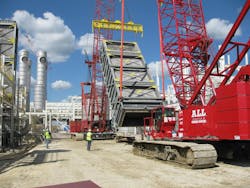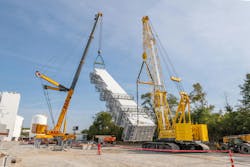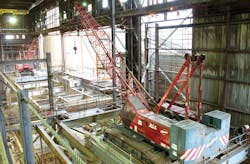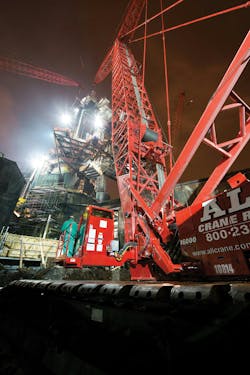Crane Lift Planning: Before the Work Begins
A Dominion Energy power station in West Virginia needed new chillers to cool down water before pumping it back into Mount Storm Lake. An 880-ton Liebherr LR 1800-1.0 crawler crane was ultimately specified to perform the chiller lifts. But before the crane was specified, the right crane partner was needed. In this case, the ALL Family of Companies—headquartered in Ohio with 29 branch locations—was called on to map the lift.
For complex lifts and challenging lift sites, before the first truckload of crane components ever arrives at a job site, the project has already been thoroughly mapped out, planned, and often practiced to precision. It’s a process called lift planning, and it’s a necessary part of preparing for maneuvers that involve materials measured in tons.
This is true of nearly any heavy lift project, but for plant retrofits, it is case critical.
In industrial or manufacturing contexts, a plant retrofit refers to the process of upgrading, modifying, or modernizing existing equipment, systems, or infrastructure within a facility—typically without a full shutdown of operations. It’s sometimes colloquially referred to as a “brownfield upgrade” or “brown out.”
Because the operational components of the plant remain mostly in service, and heavy-lift cranes must maneuver around obstacles—including underground vaults, overhead equipment, narrow pathways, and more—it’s best to have a team experienced with a wide variety of crane types, capacities, and makes, paired with the best lift-planning technology available. These should be well-trained lift planners who are constantly honing their craft.
Different Software for Different Cranes
Chad Rados is director of crawler crane operations for The ALL Family of Companies, the largest privately held crane rental and sales operation in North America. He says ALL has more than 3,600 pieces of lift equipment in its fleet, access to lift planning technology such as 3D Lift Plan, LICCON, and AutoCAD, and ongoing lift plan training.
“This access to more equipment, improved technology, and ongoing training results in professional lift plans that do more than simply sketch out what needs to be done,” said Rados.
For some lifts that may be novel or more complicated, lift planning provides a virtual reality space to try out different equipment and methods to determine the best course of action in the real world.
There is standard information that will always be part of the plan, such as crane selection, positioning and orientation, the load being lifted, where it’s being lifted from, and where it’s being set. The user also plugs in information about load weight, lift radius, boom head elevation, and more. The plant site and surrounding hazards can also be input into the planning software.
Hard work goes into taking accurate field measurements of the job site, noting any obstructions or clearance issues. This information is entered into the lift planning software to help create the virtual environment. When using 3D Lift Plan, the user can overlay a satellite image of the job site and plan the lift using a Google Earth picture of the real location. The user is also able to choose from a wide variety of Manitowoc, Link-Belt, Tadano, and Grove cranes preloaded into 3D Lift Plan.
Liebherr has its own lift planning software, LICCON (Liebherr Computed Control). It not only allows for creation of lift plans; because many Liebherr crane models have LICCON directly in the cab, the crane operator can “practice” the lift ahead of time using the controls of the actual crane they will operate during the lift. The operator can watch on screen as the virtual crane responds to their movements—an added layer of preparation before a lift.
Ground Bearing Pressure
In the case of the West Virginia power station job, because of the plant’s proximity to the lake, the lift team paid careful attention to ground bearing pressures. The concern was that moisture from the lake could seep into surrounding ground and weaken it.
In recent years, project managers from diverse markets have demonstrated a greater understanding of the role ground bearing pressure plays in a successful lift. A crane is only as solid as the ground on which it stands.
John Stolarczyk, P.E., S.E., ALL’s heavy lift engineer—who works out of Dawes Rigging & Crane Rental in Wisconsin, a member of the ALL Family of Companies—is frequently called upon to recommend appropriate crane matting for a given lift. He also custom designs mats, sending his specs to ALL’s in-house fabrication shop, where they are built in six to eight weeks.
“After we’ve determined the force, we figure out what type and size of matting we’ll need,” said Stolarczyk. “At certain radii, you’re not going to change outrigger loading unless you change the radius. If the customer says we need to stay under 3,000 pounds per square foot under matting, we’re typically not changing the lift—we’ll change what we need for support under the crane, whether set up on stone, dirt, or concrete. From there, we start adjusting the matting size.”
The larger the crane mat, the more it distributes ground bearing pressures. Standard sizes for steel mats are 6’ x 6’, 8’ x 10’, and 8’ x 12’. Timber mats are typically 4’ x 20’ and can be linked together to create longer runs over which a crawler can pick and carry.
“We appreciate the greater awareness of the importance of solid ground in a successful lift,” said Rados. “We have tools at our disposal to ‘improve upon Mother Nature,’ but knowing what we’re starting with enables us to take the necessary steps.”
In addition to lifting the chiller units in West Virginia, the crane also lifted the steel needed for the chillers’ support structures. The heaviest piece weighed an estimated 188,000 pounds. The Liebherr LR 1800, configured with a 276-foot main boom, took everything in stride and executed its lifts smoothly and with precision.
About ALL
The ALL Family of Companies is the largest privately held crane rental and sales operation in North America, operating under the ALL, ALT, Central, Dawes, and Jeffers names. For a rental quote: 800-232-4100 or www.allcrane.com.
This content is sponsored by:




